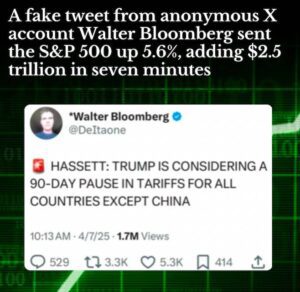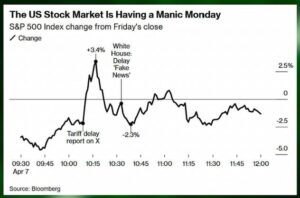April 2025 Economic And Investment Update
A Tweet, a Frenzy, and a $2.5 Trillion Round-trip all in our April 2025 Economic and Investment Update.
Markets have always been emotional — but Monday’s (April 7) intraday rally proved just how hair-trigger sensitive sentiment has become in a post selloff environment.
At 10:13 a.m. EST, an unverified tweet from the anonymous X account “Walter Bloomberg” falsely claimed that President Trump was considering a 90-day pause in tariffs for all countries except China. Within minutes, this single tweet sent shockwaves across global markets:
The S&P 500 surged 5.6%, temporarily adding $2.5 trillion in market cap in just seven minutes.

A Rapid Chain Reaction
Coming off a brutal two-month drawdown driven by tariff escalation, tight financial conditions, and slowing earnings guidance, the market was primed to react to any hint of policy relief. That reaction became a textbook case of reflexive exuberance:
1. Midcaps Lit the Fuse
By 10:14 a.m., midcap stocks — typically more sensitive to U.S. policy and supply chain costs — were the first to go green. Traders interpreted the tweet as a lifeline for manufacturing, industrials, and consumer discretionary names that had underperformed recently.
2. Tech Took the Baton
Within minutes, large cap tech surged. Nasdaq futures spiked as investors priced in improved margins, supply chain visibility, and less regulatory overhang. High beta names like AMD, Meta, and Nvidia were suddenly in full breakout mode.
3. The Full Market Melt Up
By 10:18 a.m., the S&P 500 flipped from down 1.3% to up 5.6%. Risk on sentiment was everywhere — short squeezes were triggered, algorithm models chased momentum, and retail poured in. For a moment, it looked like a full reversal of the recent downtrend was underway.
And Then… Reality
The tweet, of course, was fake. The White House officially denied the rumor at 10:41 a.m., calling the circulating claim “completely fabricated.”
President Trump doubled down with a statement: “There is no tariff pause. We are protecting U.S. industry — nothing has changed.”

The fallout was swift and unforgiving:
1. Midcaps ended the session down 0.9%.
2. Tech gave up most gains, with the Nasdaq barely clinging to +0.1%.
3. The S&P 500 closed down 0.2%, completing a full roundtrip — from panic to euphoria and back.
Lessons from the Whiplash
1. Markets Are Ultra Reactive After Painful Drawdowns
After a deep correction, sentiment becomes a tinderbox. Investors are eager for any signal of relief — real or not. The market’s violent snapback showed just how jumpy positioning had become, with cash on the sidelines and hedges being unwound at the first sign of optimism.
2. Good News Is Getting Front Run by Algorithms
The speed of the move suggests algorithmic models instantly processed the tweet’s language as bullish, with keywords like “Trump”, “90-day pause” and “tariffs” triggering trades within seconds. While these models help with liquidity, they also amplify volatility in low trust moments.
3. Fundamentals Still Matter — Eventually
Despite the fake news fueled spike, fundamentals reasserted themselves by the end of the day. Without a real policy pivot or economic data to support the move, gravity returned — fast.
Final Words
This episode reinforces a simple truth: markets are desperate for clarity, especially during periods of policy driven uncertainty. When that clarity doesn’t come, even a rogue tweet can add or erase trillions.
Or, as one market meme aptly put it: “The market really be trading like FARTCOIN.”
We continue to focus on process over noise, staying grounded in fundamental research and risk discipline.
Thanks for tuning into our April 2025 Economic and Investment Update. For more, check out the Insights page.